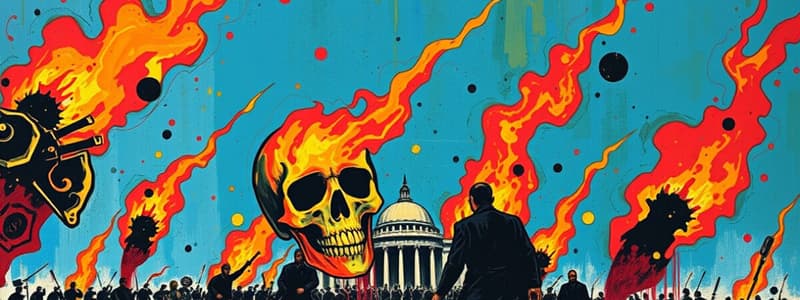Podcast
Questions and Answers
List and define the four stages of violentization.
List and define the four stages of violentization.
- Brutalization -violent subjugation, personal horrification, and violent coaching; 2. Defiance - coping mechanism for brutalization; 3. Dominance engagement - practical application of newfound violence; 4. Virulency - development of violent notoriety and social trepidation.
What are the three conditions necessary for mass extermination to occur?
What are the three conditions necessary for mass extermination to occur?
- Victims are dehumanized (correct)
- Actions are unregulated
- Actions are routinized (correct)
- Violence is authorized (correct)
Why are religious killings not a good illustration of violentization theory?
Why are religious killings not a good illustration of violentization theory?
Because religious killers often have not undergone the steps of violentization and may kill based on fervor and ideology.
What are the 10 Part 1 crimes in the Uniform Crime Report?
What are the 10 Part 1 crimes in the Uniform Crime Report?
What is the dark figure of crime and why is it a weakness in some official measures of crime?
What is the dark figure of crime and why is it a weakness in some official measures of crime?
How did the National Crime Victimization Survey improve upon the UCR?
How did the National Crime Victimization Survey improve upon the UCR?
What is the most common form of property crime according to the NCVS?
What is the most common form of property crime according to the NCVS?
Identify one factor that influences people's fear of crime.
Identify one factor that influences people's fear of crime.
Give an example of a strain that might contribute to people committing crimes.
Give an example of a strain that might contribute to people committing crimes.
Differentiate between classical and positivist theories of crime.
Differentiate between classical and positivist theories of crime.
Flashcards
Violent socialization stages
Violent socialization stages
A process of individuals becoming violent criminals, typically through four stages: Brutalization, Defiance, Dominance Engagement, and Virulency.
Mass extermination conditions
Mass extermination conditions
Three key conditions for mass extermination: official authorization of violence, routinization of violence through established rules and defined roles, and systematic dehumanization of victims.
Part 1 crimes (UCR)
Part 1 crimes (UCR)
Serious crimes tracked by the FBI's Uniform Crime Reporting (UCR) program. Examples include murder, rape, robbery, aggravated assault, burglary, larceny, motor vehicle theft, arson, and human trafficking.
Dark figure of crime
Dark figure of crime
Signup and view all the flashcards
NCVS (National Crime Victimization Survey)
NCVS (National Crime Victimization Survey)
Signup and view all the flashcards
Common property crime
Common property crime
Signup and view all the flashcards
Fear of crime
Fear of crime
Signup and view all the flashcards
Strain theory
Strain theory
Signup and view all the flashcards
Classical theory
Classical theory
Signup and view all the flashcards
Positivist theory
Positivist theory
Signup and view all the flashcards
Study Notes
Violentization Theory
- Violentization theory outlines a process through which individuals become violent criminals, consisting of four key stages.
- Brutalization involves violent subjugation (coercion through violence), personal horrification (witnessing violence), and violent coaching (learning that violence is sometimes necessary).
- Defiance serves as a coping mechanism where individuals adapt to their brutalization by adopting violent behaviors.
- Dominance engagement reflects the practical application of newfound violence, resulting in serious harm inflicted on others.
- Virulency marks the final phase, where individuals develop a reputation for violence and instill fear in their communities, leading to a resolve to become more aggressive if challenged.
Conditions for Mass Extermination
- Three critical conditions facilitate mass extermination:
- Violence must be authorized through official orders.
- Actions are made routine via established rules and clearly defined roles.
- Victims are subjected to dehumanization through systematic indoctrination.
Religious Killings and Violentization Theory
- Religious killings are generally not indicative of violentization, as perpetrators might act out of ideological fervor rather than following the steps of violent socialization.
Part 1 Crimes in the UCR
- The Uniform Crime Report (UCR) is managed by the FBI, which collects data on serious crimes across the U.S., using a standardized definition for crime comparison.
- Key Part 1 crimes include:
- Murder and nonnegligent manslaughter
- Rape
- Robbery
- Aggravated assault
- Burglary
- Larceny/theft
- Motor vehicle theft
- Arson
- Human trafficking (commercial sex acts)
- Human trafficking (involuntary servitude)
Dark Figure of Crime
- The dark figure of crime represents unreported crimes, leading to gaps in police reports and official crime statistics. This suggests official crime data may not accurately represent the true scope of crime.
National Crime Victimization Survey (NCVS)
- The NCVS serves as a primary source of information on crime in the U.S., focusing on how frequently crime occurs and its characteristics.
- It gathers data directly from crime victims, capturing incidents often overlooked by law enforcement, enhancing overall crime representation.
Common Property Crime
- Theft ranks as the most prevalent form of property crime reported by the National Crime Victimization Survey.
Factors Influencing Fear of Crime
- Public fear of crime often exceeds the actual risk of victimization, with women generally exhibiting greater fear than men.
- Media coverage plays a significant role in shaping public fear, potentially exaggerating perceptions of crime prevalence.
Strain Contributing to Crime
- Financial struggles and the inability to achieve social status can serve as strains that may lead individuals toward criminal behavior.
Classical vs. Positivist Theories
- Classical theory posits that crime results from individual choice, weighing the benefits against potential costs.
- Positivist theory argues that criminal behavior is influenced or determined by external factors beyond an individual's control.
Studying That Suits You
Use AI to generate personalized quizzes and flashcards to suit your learning preferences.
